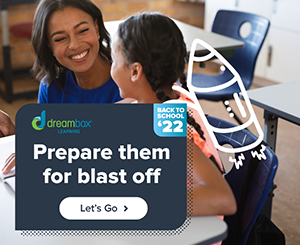Most families have given up virtual school, but what about students who are still thriving online?
RIO RANCHO, N.M. — When Ashley Daniels saw her second grade son earn a high score on a recent test, she knew he had just guessed the answers and gotten lucky. Daniels called his teacher and said he might need some extra support, despite his good performance on the test.
It wasn’t just a mother’s intuition. Daniels watched her son take the test from their dining room table.
The second grader attends SpaRRk Academy, a virtual learning program for elementary students created in 2021 by the Rio Rancho School District in New Mexico. Even as doors reopened to brick-and-mortar schools, administrators here saw the continued need for a virtual option in response to lingering concerns about Covid and to feedback from some parents that their children had thrived in online learning.
The district assigned 10 full-time teachers to provide live, online classes via Zoom. They also organized an in-person component: Once a week, students would gather in reserved classrooms in a local elementary school, for activities such as science experiments, project-based learning and reading groups. More than 250 kids signed up for SpaRRk.

But, two years in, enrollment had dropped to 87 kids, a 65 percent decrease. Costs had soared to $11,327 per pupil, a 121 percent jump from the year prior and nearly $3,000 more than the average in this district of roughly 17,000 students. SpaRRk Academy’s future sat on shaky ground; the school board announced in late 2022 that it would hold a vote this spring on whether to shutter the academy altogether.
Prior to the pandemic, virtual schools were relatively scarce: 691 fully virtual programs enrolled nearly 294,000 students, accounting for less than 1 percent of national public school enrollment, according to the National Center for Education Statistics. But after most schools shifted their classes online in early 2020, remote learning caught on with some families, including those who preferred to give their children the flexibility of learning from home, or whose children struggled with social anxiety in school buildings or hadn’t found success in traditional learning environments.
Related: Remote learning has been a disaster for many students. But some kids have thrived
Some 41 percent of districts surveyed in August 2021 by the Clayton Christensen Institute, a nonprofit think tank, said they had opened a full-time virtual school option during the pandemic, and 32 percent planned to maintain these programs after the pandemic subsided.
But today, as Covid fears have waned, many students have tired of screens and employers have begun requiring workers to return in person, a number of those virtual academies are at risk of closing. That’s leaving families like Daniels’ in the lurch, and raising questions about the future of virtual learning. The highest-quality online programs have generally demanded the most resources from school districts, making them the most likely to face closure in the face of budget constraints.

“Do we continue to fund something that is showing declining enrollment?” said Rachel Aaker, the principal of SpaRRK Academy, who spearheaded its creation. “I believe it would take commitment from the district and the board to say we may see an increasing need for this eventually, and we need some years for that to play out.”
Tucked in the foothills of the Sandia Mountains in Northern New Mexico, Rio Rancho is a small but rapidly growing school district. New schools are being built every few years to keep pace with a surge in families moving to the area due to its proximity to technology and engineering firm Sandia National Laboratories and new business hubs for companies such as Intel and NTX Bio. The high desert landscape is dotted with signs of development: brand new farmhouse-style homes, fresh asphalt still jet-black from lack of use and “for sale” placards on empty plots of land.
A longtime administrator in Rio Rancho, Aaker led the district-wide transition of elementary students to online learning when Covid struck. As public health guidelines relaxed over the course of the next school year, Aaker began to hear from parents who weren’t comfortable sending their kids back to in-person learning. She approached the board with the idea of a stand-alone hybrid program run by the district that any elementary student in Rio Rancho could attend.

Since 2005, the district had operated a virtual option, Cyber Academy, for middle and high schoolers, which relied primarily on a third-party platform, Edgenuity, for lessons students could perform on their own at their own pace and offered some in-person academic support and extracurriculars. Aaker’s new elementary option was to be different, though, with its real-time, live instruction designed by district administrators and led by district teachers.
Daniels and another parent, Nicole Garcia, who sent two children to SpaRRk, opted for the program due to Covid fears. Once enrolled, their children grew more confident and their academic performance improved, said Daniels and Garcia, and they became believers in the model for the long haul. That was true for many SpaRRk parents: District surveys of SpaRRk families found that health concerns were the biggest initial draw, but by 2022 parents instead cited the program’s quality, the school’s close collaboration with families and the flexibility as reasons why they stayed.
Still, that enthusiasm wasn’t enough: The academy lost its biggest class, of 54 fifth graders, when they graduated to middle school in 2022, while other families moved out of the school district or returned to in-person learning as Covid fears dissipated. Enrollment at Rio Rancho’s Cyber Academy for older students also declined, from 285to205 this year.
That mirrors what’s happening in other districts. Overall, total virtual enrollment remains higher than before the pandemic, but, in some cases, it has declined relative to its pandemic peaks, according to Gary Miron, a professor with Western Michigan University’s Department of Educational Leadership, Research and Technology.

In Indianapolis Public Schools, for example, 782 families opted into the district’s full-time online offering during the 2021-22 school year; today that figure is 508. When Salt Lake Virtual Elementary in Utah’s Salt Lake City School District opened for the 2021-22 school year, 257 students enrolled, but that number plummeted to 87 students this year. This June, the school board plans to decide whether to close the school altogether. Nearby Jordan School District’s virtual elementary option, Rocky Peak Virtual Elementary, saw enrollment drop from 604 students during the height of the pandemic to 273 students this year. Wyoming Virtual Academy, a virtual option available to K-12 students statewide, saw enrollment surge from roughly 500 students every year since its founding in 2009 to nearly 1,200 students at the height of the pandemic. Enrollment fell to about 600 students for this school year.
Related: Despite mediocre records, online charter schools are selling families on staying virtual
Less than 20 miles south of Rio Rancho, the Albuquerque eCADEMY High School, a virtual program created by the Albuquerque school district in 2013, saw enrollment jump during the pandemic from 276 students to 726. Seeing this demand, the Albuquerque school board voted in June 2020 to allocate $8 million in pandemic relief to create eCADEMY K8 and expand virtual offerings to lower grades. In its first year, nearly 1,400 students enrolled, according to data made publicly available by APS.
This school year, enrollment dropped for both eCADEMY programs — to about 950 high schoolers and 747 elementary and middle schoolers, though the numbers remain well above pre-Covid figures. While many students stay enrolled in eCADEMY’s high school program for increased flexibility, principal Erin Easley said the program also sees large percentages of students who are coping with debilitating medical conditions or social anxiety, while others come from difficult home environments or have historically struggled to succeed in the classroom.

Virtual enrollment may be dropping due to questions around the quality of remote learning. Student academic performance took a beating during the online learning experiment of the pandemic. Data from the National Assessment of Educational Progress, known as the nation’s report card, shows that fourth graders lost the equivalent of two decades of progress in reading and math, and eighth grade math performance fell in all but one state. And research on some online academies that existed pre-pandemic, including for-profit online charter schools, has tended to show poor student outcomes and low graduation rates.
Yet a growing number of educators and researchers caution against making conclusions about virtual learning based on that research. The transition to online learning during the pandemic was haphazard; online programs have continued to evolve and improve. Parents will increasingly expect districts to offer a virtual learning alternative as technology’s role grows and pandemic-era workplace flexibility becomes more commonplace, education experts say.
“The idea that we think our education systems are going to remain paper- and pencil-based and in this face-to-face instructional model — it’s going to change,” said Miron, the Western Michigan University professor. “It is changing.”

But the approach that districts take matters. When the time came to select a middle school for her older child, Garcia said the family chose Cyber Academy, Rio Rancho’s existing virtual program for grades 6-12. She quickly found that it was “not even comparable” to the experience at SPaRRk, she said, and withdrew her daughter after winter break in favor of the local middle school.
“SpaRRk teachers took the time to hang around to go over any questions the students had, and made themselves available throughout the day. They are wonderful. I’ve never dealt with teachers like them,” said Garcia. “At Cyber Academy, the teachers and curriculum were not great, and the teachers didn’t offer help when kids needed it.”
Education experts say the most successful online programs tend to be those that provide individual attention to students, staff the school with dedicated district employees, guarantee low teacher-to-student ratios and rely on curriculum developed by school districts rather than off-the-shelf programs run by for-profit charter schools or other companies. Hybrid programs that incorporate some in-person learning and extracurricular activities, like SPaRRk’s, have been most successful at providing the benefits of online learning while retaining the social skills some fear could be lost in a virtual environment, according to Miron and others. But as Rio Rancho is finding, such programs require significant resources that can be hard to justify if student enrollment falls.
At the Rio Rancho Board of Education building overlooking the Sandia Mountain foothills, dozens gathered in February for a vote on the online academy’s future.
Most who spoke favored keeping it open. “At least give us a chance, give the community a chance to know about this program,” pleaded Ruby Holden, a special education teacher at SPaRRk Academy, during public comment. “We just need an opportunity to have our program open for parents and families to know about us and I just don’t feel like we’ve had the opportunity to spread the word about our program.”
But when Aaker was pressed on how many kids she could enroll in the next two years, she said about “one class per grade level,” or 20 to 25 students each, more than current enrollment but not the 300-plus target she had thought might be viable when SpaRRk Academy was first founded.
Less than an hour later, the board voted to close the school after only two years in operation.

“Enrollment is not going in the right direction,” Sue Cleveland, the Rio Rancho superintendent, said at the meeting. “It’s substantially more expensive than what we are spending on other students in the district. I wish we had enough resources that we didn’t have to make hard choices like sometimes we have to make.”
After the vote, SpaRRk families and administrators shared tears and hugs. “We wish we had more time to provide an opportunity for our school to grow,” said Aaker.
Garcia, who was not in attendance at the meeting, said she’ll enroll her rising fourth grader in the local brick-and-mortar option, which, she said, “is not what we would want at this time.”
Daniels said she plans to homeschool her son for the upcoming school year, rather than sending him back to a local public school. “I think it’s such a loss for the district,” she said. “I feel like they are taking three steps back.”
“Ironically, one of the board members was literally attending the meeting virtually,” she added. “I guess we do board meetings virtually — but not learning.”
This story about online academies was produced by The Hechinger Report, a nonprofit, independent news organization focused on inequality and innovation in education. Sign up for the Hechinger newsletter.



